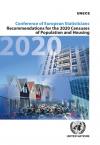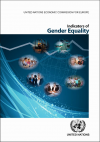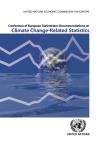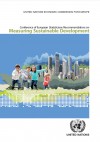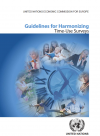Publications
Displaying Results 21 - 40 of 80
- Pусский
Statistics on social and demographic topics are usually produced from surveys of private households. People living in institutions are often excluded because it can be complicated and expensive to identify and sample the institutions and their residents.
But populations across the UNECE region and throughout the world are growing older, and for many countries this means that the population of
- English
Statistics on social and demographic topics are usually produced from surveys of private households. People living in institutions are often excluded because it can be complicated and expensive to identify and sample the institutions and their residents.
But populations across the UNECE region and throughout the world are growing older, and for many countries this means that the population of
- English
The world is becoming more interconnected, with an acceleration in the movement of information, capital, goods, services and people across international borders. As it becomes easier to travel and work in other countries – especially in common market areas such as the European Union – the expansion of international labour mobility has become a topic of growing policy importance.International
- English
Migration shapes societies. Its economic, social and demographic impacts are large and increasing. Policymakers, researchers and other stakeholders need data on migrants – how many there are, their rates of entry and exit, their characteristics, and their integration into societies. These data need be comprehensive, accurate and frequently updated. There is no single source that can
- English
The purpose of this publication is to guide national statistical offices and other responsible agencies on the use of registers and administrative data in population and housing censuses, including operational, practical, technical and legal aspects.
The publication was prepared by a task force established by the Conference of European Statisticians (CES), composed of experts from
- English
This publication contains a series of good practices and recommendations on effectively communicating the results of population projections. Here, “communication” encompasses not only how projections should be disseminated to users, but also what should be communicated. The aim is to improve the coherence between what is produced by national statistical offices and what is needed by users,
- English
Conventional economic statistics, such as national accounts and employment measures, are largely designed to measure the market economy and in most countries exclude unpaid household service work. Economists have argued for many years that ignoring these services introduces biases in various areas of economic analysis. For instance, an increase in childcare or long-term care provided by the
- English
The 2nd edition of the Road Map, published in February 2022, can be found here.
The publication provides guidance to national statistical offices on producing statistics for SDGs. It lays out what needs to be done, who are the stakeholders, and what are the opportunities for cooperation. The Road Map deals with
- English
Circular migration – a repetition of migration by the same person between two or more countries – is a topic of growing importance, on which information is needed for policy development. To meet this demand, tools must be established to better measure the extent to which existing international migration patterns become more (or less) circular over time and to evaluate policies aiming at
- Pусский
Миграция является мощным драйвером и важным следствием экономических, политических и социальных изменений. Поэтому ее необходимо соответствующим образом измерять и понимать. Тем не менее, совершенствование статистических систем по измерению миграции проходит медленно из-за слабого взаимодействия между производителями статистических данных по миграции, расхождениями в применяемых определениях и
- English
Migration is a powerful driver and important consequence of economic, political and social change, and therefore needs to be adequately measured and understood. However, the improvement of statistical systems to measure migration has been a slow process because of weak coordination between migration statistics producers, discrepancies in the applied definitions, and challenges related to data
- English
The population and housing census provides, at regular intervals, information on the number and characteristics of the population of a country, and on its housing stock. It is an essential source of information for small-area, national, regional and international planning and development. This publication reviews the practices followed by countries in Eastern Europe, Caucasus and Central
Conference of European Statisticians Recommendations for the 2020 Censuses of Population and Housing
- English
The main objectives of the Conference of European Statisticians Recommendations for the 2020 Censuses of Population and Housing are: to provide guidance and assistance to countries in the planning and execution of their population and housing censuses; and to facilitate and improve the comparability of census at the UN regional level through the identification of a core set of census topics
- English
The increased movement of people across international borders has brought the issue of migrant integration to the forefront of national polices. International migration can have great societal and economic impacts, both positive and negative, on both individuals and countries of origin and destination, particularly when viewed through the lens of time. Thus, improved measurement of
- English
Statistics and indicators that reflect the realities of the lives of women and men are needed to describe women’s and men’s role in the society, economy and family, to formulate and monitor policies and plans, monitor changes, and inform the public. In 2010, the Conference of European Statisticians (CES) established the Task Force on Indicators of Gender Equality, to improve the monitoring of
- English
These first ever Recommendations on Climate Change-Related Statistics are aimed at improving existing official statistics to support climate change analysis and reporting on greenhouse gas emissions under the Kyoto Protocol. The focus is not on scientific or meteorological data describing changes in weather and climate, but rather on statistics that are relevant for analysing climate change,
- English
This publication reviews the practices followed by countries in the UNECE region (covering Europe, Central Asia and North America) during the 2010 round of population and housing censuses. The aim is to compare the different approaches and practices adopted by the countries and to assess the compliance with the Conference of European Statisticians (CES) Recommendations developed for
- English
The last two decades have seen a proliferation of methods and indicators to measure sustainable development. Many countries and organizations have adopted sustainable development indicator sets to track progress towards a sustainable society. However, the differences between the approaches remain large. Therefore, the Conference of European Statisticians set up in 2009 a joint UNECE/Eurostat/
- English
The objectives of these Guidelines are to (a) help statisticians and policymakers understand the importance of time-use surveys, (b) provide guidance in the design and implementation of time-use surveys, and (c) improve the international comparability of their results. The Guidelines include recommendations of preferred or best practice, based on the experience of member countries
- English
This document contains a set of questions on health state, to enable the production of internationally comparable measurements for this topic. It reflects the work of the Budapest Initiative Task Force, composed of experts from many countries and international organizations. The Budapest Initiative recommends the inclusion of these questions in health interview surveys, organised at the



